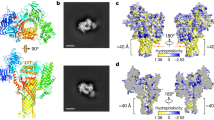Summary
The plant pathogenic bacteriumClavibacter michiganense ssp. nebraskense secretes an anion channel forming activity (CFA) into the culture fluid. The CFA inserts spontaneously into planar lipid membranes when culture fluid of this species is added to the aqueous phase of the bilayer chamber. The channels formed are highly anion selective. The conductance decreases for larger anions (Cl−>SCN−>SO 2−4 ) and is practically zero for gluconate. The channels show a unique voltage dependence : (i) The single-channel conductance increases linearly with voltage up to 200 mV saturating at 250 mV with 25±1 pS (300mm KCl). The channel is closed at negative voltage relative to the side of insertion (diode-typeI–V curve). (ii) The average number of open channels also increases with voltage. The Poisson distribution of channel numbers indicates independent opening of the channels.
Channel activity can be abolished by protease treatment of the planar bilayer. The channels can be blocked by indanyloxyacetic acid (IAA-94) and by pH>10. The CFA was purified yielding one major band on the SDS gel with a relative molecular mass of 65,000. The putative involvement of the CFA in the toxicity of this plant pathogen is discussed and compared to other toxins like colicins and to the diphtheria toxin group.
Similar content being viewed by others
References
Bamberg, E., Janko, K. 1976. Single channel conductance at lipid bilayer membranes in presence of monazomycin.Biochim. Biophys. Acta 426:447–450
Barksdale, L. 1970.Corynebacterium diphteriae and its relatives.Bacteriol. Rev. 34:378–422
Boheim, G., Hanke, W., Jung, G. 1983. Alamethicin pore formation: Voltage-dependent flip-flop of α-helix dipoles.Biophys Struct. Mech. 9:182–191
Bretag, A.H. 1987. Muscle chloride channels.Physiol. Rev. 67:619–724
Dankert, J.R., Esser, A.F. 1986. Complement-mediated killing ofEscherichia coli: Dissipation of membrane potential by a C9-derived peptide.Biochemistry 25:1094–1100
Davis, M.J., Gillaspie, A.G., Vidaver, A.K., Harris, R.W. 1984.Clavibacter: A new genus containing some phytopathogenic coryneform bacteria, includingClavibacter xyli subsp.xyli sp.nov., subsp.nov. andClavibacter xyli subsp.cynodontis subsp.nov., pathogens that cause ratoon stunting disease of Sugarcane and Bermudagrass stunting disease.Int. J. Sys. Bacteriol. 34:107–117
Fong, T.M., McNamee, M.G. 1986. Correlation between acetylcholine receptor function and structural properties of membranes.Biochemistry 25:830–840
Hanke, W., Boheim, G. 1980. The lowest conductance state of the alamethicin pore.Biochim. Biophys. Acta 596:456–462
Hanke, W., Methfessel, C., Wilmsen, H.-U., Katz, E., Jung, G., Boheim, G. 1990. Melittin and a chemically modified trichotoxin form alamethicin-type multi-state pores.Biochim. Biophys. Acta 727:108–114
Harris, J.B. (editor) 1986. Natural Toxins. Clarendon, Oxford
Hartsel, S.C., Perkins, W.R., McGarvey, G.J., Cafiso, D.S. 1988. A selective cholesterol-dependent induction of H+/OH− currents in phospholipid vesicles by amphotericin B.Biochemistry 27:2656–2660
Hartung, W., Ullrich-Eberius, C.I., Novacky, A. 1987. Effects of the phytotoxins tentoxin, HmT-toxin, and HV-toxin on K+ efflux from unilamellar liposomes.Plant Sci. 49:9–13
Hille, B. 1984. Ionic Channels of Excitable Membranes. Sinauer, Sunderland (MA)
Holden, M.J., Colombini, M. 1988. On the reported channel-forming activity of HmT toxin [letter].J. Membrane Biol. 103:205–206
Holden, M.J., Colombini, M., Sze, H. 1985. Channel formation in phospholipid bilayer membranes by the toxin ofHelminthosporium maydis, race T.J. Membrane Biol. 87:151–157
Krämer, R., Leistner, H.-U. 1986. Physiological and cytological aspects of action of the toxin fromCorynebacterium michiganense pv. michiganense (Smith) Jensen on the hostplant.Zentralbl. Mikrobiol. 141:437–451
Landry, D.W., Akabas, M.H., Redhead, C., Edelman, A., Cragoe, E.J., Jr., Al-Awqati, Q. 1989. Purification and reconstitution of chloride channels from kidney and trachea.Science 244:1469–1472
Lazdunski, C.J. 1988. Pore-forming colicins: Synthesis, extracellular release, mode of action, immunity.Biochimie 70:1291–1296
Martin, J.F., Santamaria, R., Sandoval, H., del Real, G., Mateos, L.M., Gil, J.A., Aguilar, A. 1987. Cloning systems in amino acid-producing corynebacteria.Biol/Technology 5:137–146
Michaels, D.W. 1979. Membrane damage by a toxin from the sea anemoneStoichactis helianthus. I. Formation of transmembrane channels in lipid bilayers.Biochim. Biophys. Acta 555:67–78
Michaels, D.W., Abramovitz, A.S., Hammer, C.H., Mayer, M.M. 1976. Increased ion permeability of planar lipid bilayer membranes after treatment with the C5b-9 cytolytic attack mechanism of complement.Proc. Natl. Acad. Sci. USA. 73:2852–2856
Miller, G.L. 1959. Protein determination for large numbers of samples.Anal. Chem. 31:964
Miller, C., White, M.M. 1984. Dimeric structure of single chloride channels fromTorpedo electroplax.Proc. Natl. Acad. Sci. USA. 81:2772–2775
Muller, R.U., Finkelstein, A. 1972. Voltage-dependent conductance induced in thin lipid membranes by monazomycin.J. Gen. Physiol. 60:263–284
Rai, P.V., Strobel, G.A. 1968. Phytotoxic glycopeptides produced byCorynebacterium michiganense: 1. Methods of preparation, physical and chemical characterization.Phytopathology 59:47–52
Schindler, H. 1980. Formation of planar bilayers from artificial or native membrane vesicles.FEBS Lett. 122:77–79
Schürholz, Th., Gieselmann, A., Neumann, E. 1989. Miscibility gap of octyl glucoside-phosphatidylcholine micellar solutions. Partition of the nicotinic acetylcholine receptor into the surfactant-rich phase.Biochim. Biophys. Acta 986:225–233
Schürholz, Th., Weber, J., Neumann, E. 1989. Reconstitution of theTorpedo californica nicotinic acetylcholine receptor into planar lipid bilayers.Bioelectrochem. Bioenerg. 21:71–81
Slatin, S.L., Raymond, L., Finkelstein, A. 1986. Gating of a voltage-dependent channel (colicin E1) in planar lipid bilayers: The role of protein translocation.J. Membrane Biol. 92:247–254
Tschopp, J., Jongeneel, C.V. 1988. Cytotoxic T lymphocyte mediated cytolysis.Biochemistry 27:2642–2646
Van Alfen, N.K., McMillian, B.D. 1982. Macromolecular plant-wilting toxins: Artefacts of the bioassay method.Phytopathology 72:132–135
Vidaver, A.K. 1982. The plant pathogenic Corynebacteria.Annu. Rev. Microbiol. 56:495–517
Vogel, P., Stynes, B.A., Coackley, W., Yeoh, G.T., Petterson, D.S. 1982. Glycolipid toxins from parasitised annual ryegrass: A comparison with tunicamycin.Biochem. Biophys. Res. Commun. 105:835–840
Weber, J., Schürholz, T., Neumann, E. 1989. The nematocyst extract ofHydra attenuata causes single channel events in lipid bilayers.Toxicon 28:403–409
Wyosong, D.S., Vidaver, A.K., Stevens, H., Stenberg, D. 1973. Occurrence and spread of an undescribed species ofCorynebacterium pathogenic on corn in the western corn belt.Plant Dis. Rep. 57:291–294
Author information
Authors and Affiliations
Rights and permissions
About this article
Cite this article
Schürholz, T., Wilimzig, M., Katsiou, E. et al. Anion channel forming activity from the plant pathogenic bacteriumClavibacter michiganense ssp. nebraskense . J. Membrain Biol. 123, 1–8 (1991). https://doi.org/10.1007/BF01993957
Received:
Revised:
Issue Date:
DOI: https://doi.org/10.1007/BF01993957




